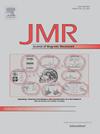铷- 129xe自旋交换光泵浦的有限元建模及优化铷源分布
IF 1.9
3区 化学
Q3 BIOCHEMICAL RESEARCH METHODS
引用次数: 0
摘要
铷(Rb)蒸气密度([Rb])是自旋交换光泵浦中氙-129极化(PXe)形成的关键参数。实际上,单元内的[Rb]通常低于饱和水平,并且在空间上不均匀,导致系统性能不佳。本研究通过有限元建模研究了Rb源分布在非均质胞内[Rb]中的作用,并对Rb预饱和器进行了优化,以实现均匀[Rb]并降低对[Rb]流量的依赖。在我们之前的偏振器迭代中,低于预期的PXe可归因于亚饱和[Rb],这是由于主胞体中Rb源的小表面积和上游Rb蒸气压力的缺乏,导致PXe低于预期。我们发现,增加主细胞体Rb源的表面积并不能有效降低[Rb]的异质性。相反,要实现[Rb]的更均匀分布,就需要在给定的气体流速下使用足够长的预热器,从而增加PXe。我们还报告了模型和实验测量的激光吸收之间的差异,突出了现有光泵模型的局限性,并为未来的模型修订和目前未开发区域的研究提出了方向。本文章由计算机程序翻译,如有差异,请以英文原文为准。

Finite element modeling of Rb-129Xe spin-exchange optical pumping and optimized Rb source distribution
Rubidium (Rb) vapor density () is a key parameter in xenon-129 polarization () build up in spin-exchange optical pumping. In practice, within the cell often falls below saturation levels and is spatially heterogeneous leading to system underperformance. In this study, finite element modeling was performed to investigate the role of Rb source distribution in heterogeneous in-cell , and to optimize a Rb presaturator to achieve homogeneous and reduce the flow rate dependence of . Lower than expected in previous iterations of our polarizer can be attributed to sub-saturation due to the small surface area of the Rb source in the main cell body and the absence of upstream Rb vapor presaturation, leading to lower than desired . We found that increasing the surface area of the Rb source in the main cell body does not effectively reduce heterogeneity. Instead, achieving a more uniform distribution of necessitates the use of a sufficiently long presaturator at a given gas flow rate, increasing . We also report discrepancy between modeled and experimentally measured laser absorption, highlighting limitations of the existing optical pumping model and suggesting directions for future model revisions and the investigation of currently unexplored areas.
求助全文
通过发布文献求助,成功后即可免费获取论文全文。
去求助
来源期刊
CiteScore
3.80
自引率
13.60%
发文量
150
审稿时长
69 days
期刊介绍:
The Journal of Magnetic Resonance presents original technical and scientific papers in all aspects of magnetic resonance, including nuclear magnetic resonance spectroscopy (NMR) of solids and liquids, electron spin/paramagnetic resonance (EPR), in vivo magnetic resonance imaging (MRI) and spectroscopy (MRS), nuclear quadrupole resonance (NQR) and magnetic resonance phenomena at nearly zero fields or in combination with optics. The Journal''s main aims include deepening the physical principles underlying all these spectroscopies, publishing significant theoretical and experimental results leading to spectral and spatial progress in these areas, and opening new MR-based applications in chemistry, biology and medicine. The Journal also seeks descriptions of novel apparatuses, new experimental protocols, and new procedures of data analysis and interpretation - including computational and quantum-mechanical methods - capable of advancing MR spectroscopy and imaging.

 求助内容:
求助内容: 应助结果提醒方式:
应助结果提醒方式:


